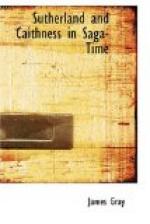[Footnote 8: O.P., ii, p. 603. As regards the marriage of Iye Mor Mackay to the daughter of Walter de Baltroddi (Bishop), see Book of Mackay, p. 37.]
[Footnote 9: Hakon Saga, 312, 314.]
[Footnote 10: Do. 317.]
[Footnote 11: Sutherland Book, vol. 1, p. 15. Genealogie of the Earls, p. 33.]
[Footnote 12: Hakon Saga, 319.]
[Footnote 13: Hakon Saga, 318. As to the hostages and their expenses see Compot. Camer. 1-31. From additions to Hakon’s Saga, Rolls edition, it appears that Caithness was also fined and an army sent there by the king of Scotland with a view to the conquest of Orkney.]
[Footnote 14: Hakon Saga, 319. The calculation was made by Sir David Brewster.]
[Footnote 15: Also called Port Droman. Possibly Hals-eyar-vik = neck-island-bay.]
[Footnote 16: Hakon Saga, 318.]
[Footnote 17: Hakon Saga, 327.]
[Footnote 18: There is a tradition that Hakon slaughtered cattle on Lechvuaies, a rock in Loch Erriboll.]
[Footnote 19: Hakon Saga, 328-331. Goafiord—Eilean Hoan at the entrance to Loch Erriboll still retains the name.]
[Footnote 20: See Tudor, Orkney and Shetland, p. 307. What happened to Earl Magnus III, who in July 1263 had been obliged to join his overlord, King Hakon, and sail with him from Bergen? The Orkneymen were far from Norway, but dangerously close to Scotland. Their jarl had large possessions in Caithness, which he feared to lose if he made war on the Scottish king. Magnus therefore “stayed behind” in Orkney, and never went to Largs, but probably went to the Scottish king. Caithness first suffered from levies of cattle and provisions at the hands of Hakon, and afterwards from fines levied and hostages taken by the Scottish King, who sent an army, no doubt under the Chens and Federeths and others, to threaten Orkney and hold Caithness and levy the fine. Dugald, king of the Sudreys, intercepted the fine, and disappeared. Orkney had a Norse garrison, and the Scottish army never went to Orkney, Magnus was reconciled to Alexander III, and after the Treaty of Perth, in 1267, was reconciled also to King Magnus of Norway, on terms that he should hold Orkney of him and his successors, but that Shetland should remain a direct appanage of the Norse Crown, as it had been ever since Harold Maddadson’s punishment in 1195. (See Munch’s History of Norway; and Torfaeus Orcades, p. 172; and King Magnus Saga, Rolls edition of Hakon’s Saga, pp. 374-7).]
CHAPTER XI.
[Footnote 1: Scandinavian Britain, p. 62. To Orkney and Shetland they came mainly from the fjords north of Bergen.]
[Footnote 2: Oxford Essays, 1858, p. 165, Dasent, an admirable account of the Norsemen in Iceland.]




